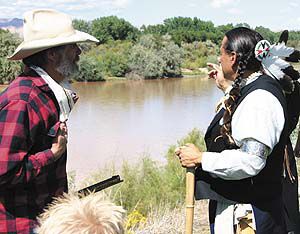| Michael Kane as William Manly and Lakota John as Chief Wakara re-enact Manly’s landing in Green River. |
Was William Manly first?
William Manly’s memoir, “Death Valley in 1849” reveals more than just his harrowing experience of survival in Death Valley, Calif. on his way to the California gold fields. When he heard tales of the gold finds early in 1849, Manly left his home and family in Michigan and struck out for California to find his fortune. Prior to arriving in Death Valley, Manly tells of a trek down the Green River and through Utah that predates John Wesley Powell’s exploits by 20 years.
Michael Kane, an instructor at the University of Utah in the college of health, parks, recreation and tourism, is retracing Manly’s steps to prove the trek Manly wrote about could be accomplished. This trip is part of Kane’s completion of his Ph.D. On the 37th day of Kane’s journey, he passed through Castle Dale on very nearly the same day in September that Manly did in 1849.
Kane stated that the Manly memoir is very graphic in description and notation of the locations along his journey. Following extensive research over the past six years, Kane decided to undertake this retracing of Manly’s steps. “This is quite exciting that America’s first American whitewater explorer passed through Castle Dale,” said Kane.
The Kane trek began near Green River, Wyo. as did Manly’s. Manly was in Green River, Wyo. looking for transportation to California. He was told he would have to spend the winter there. Because he didn’t want to waste time, he began to consider his options and decided that if he only had a boat, he could follow the Green River to the Colorado River and then on to California.
Manly located a flat bottomed boat, but that boat did not last long in the river. He had to hollow out a Ponderosa Pine log into a canoe to continue the float trip. When he reached Green River, Utah, Manly met Chief Wakara, and the men quickly became friends. Chief Wakara explained that to continue in the river would mean certain death. Manly believed him and changed his plans.
| Lakota John speaks to those gathered at the re-enactment in Green River. He tells of the friendship between Chief Wakara and William Manly. |
Kane, his son Dallas, and Clint Goode launched their log dug-out canoes in the Green River on Aug. 15 at Lombard Crossing near Green River, Wyo. to create their own history for the books. Goode acted as the river guide and the crew spent 34 days on the 450 miles of the Green River until finally getting out at Green River, Utah. Most of the history books note Manly’s river exit as being in Vernal.
A re-enactment of the Manly landing in Green River was held at the John Wesley Powell River History Museum during Melon Days. Lakota John, of St. George, portrayed the chief in the re-enactment.
Chief Wakara pointed out an alternative route for the Manly crew to continue overland. Manly gave Chief Wakara a coat, and in return Chief Wakara gave the travelers two horses. This was the beginning of Manly’s journey through Emery County.
Kane said, “I find it very moving that two men of such different cultures and races could stand eye to eye and help each other in such a profound way.” Manly would note in his memoir that he owed his life to Chief Wakara.
Kane’s group began the overland portion of Manly’s trek on Sept. 18 in Green River, and were met there by wrangler Kody Jacobs of Pleasant Grove, with the horses. The group passed through Castle Dale on Sept. 20 on their way to Joe’s Valley and over the top into Ephraim. Manly’s memoir stated that the overland portion of the trip took 10 days to reach Hobble Creek Canyon from Green River, and Kane’s crew is hoping to reach Hobble Creek by Sept. 27.
The wrangler brought along the horses to keep the retracing as close to Manly’s memoir as possible. The group will continue on to Hobble Creek Canyon where Manly’s original trek ended when he joined a wagon train headed for California, although Manly’s adventure did not end there.
During Manly’s time with the wagon train, they were stranded in Death Valley, Calif. with little food and almost no water. Manly and another man, John Rogers, left the group that consisted of the Arcane and Bennett families, and headed for help, hoping to return with enough food and water to get the people in the wagon train to California.
Several weeks later, the men returned with food and water, and led the stranded wagon train out of Death Valley. As the wagon train was leaving the hot, desolate valley, Mrs. Bennett was noted as saying “Goodbye Death Valley.” The name stuck through the years .

